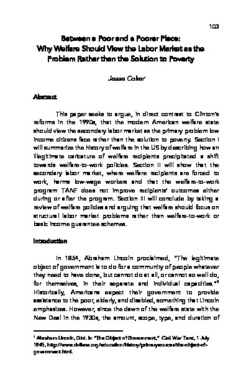| dc.contributor.author | Coker, Jesse | |
| dc.date.accessioned | 2016-06-12T18:40:57Z | |
| dc.date.accessioned | 2021-04-14T14:29:46Z | |
| dc.date.available | 2016-06-12T18:40:57Z | |
| dc.date.available | 2021-04-14T14:29:46Z | |
| dc.date.issued | 2016 | |
| dc.identifier.uri | https://hdl.handle.net/11244.46/89 | |
| dc.description | Copyright © 2016, The Honors Undergraduate Research Journal, University of Oklahoma. All rights revert to authors. | en_US |
| dc.description.abstract | This paper seeks to argue, in direct contrast to Clinton’s
reforms in the 1990s, that the modern American welfare state
should view the secondary labor market as the primary problem low
income citizens face rather than the solution to poverty. Section I
will summarize the history of welfare in the US by describing how an
illegitimate caricature of welfare recipients precipitated a shift
towards welfare-to-work policies. Section II will show that the
secondary labor market, where welfare recipients are forced to
work, harms low-wage workers and that the welfare-to-work
program TANF does not improve recipients’ outcomes either
during or after the program. Section III will conclude by taking a
review of welfare policies and arguing that welfare should focus on
structural labor market problems rather than welfare-to-work or
basic income guarantee schemes. | en_US |
| dc.description.sponsorship | The Honors Undergraduate Research Journal (THURJ) is a publication of the Joe C. and Carole Kerr McClendon Honors College at the University of Oklahoma. The views expressed in THURJ are solely those of the contributors and should not be attributed to the Editorial Staff, the Honors College, or the University of Oklahoma. | en_US |
| dc.language.iso | en_US | en_US |
| dc.relation.ispartofseries | THURJ: The Honors Undergraduate Research Journal;Volume 15 | |
| dc.rights | Attribution-NonCommercial-ShareAlike 3.0 United States | * |
| dc.rights.uri | https://creativecommons.org/licenses/by-nc-sa/3.0/us/ | * |
| dc.subject | Secondary Labor Market | en_US |
| dc.subject | United States Welfare State | en_US |
| dc.subject | Temporary Assistance to Needy Families (TANF) | en_US |
| dc.title | Between a Poor and a Poorer Place: Why Welfare Should View the Labor Market as the Problem Rather than the Solution to Poverty | en_US |
| dc.type | Article | en_US |
| dc.description.undergraduate | undergraduate | |

